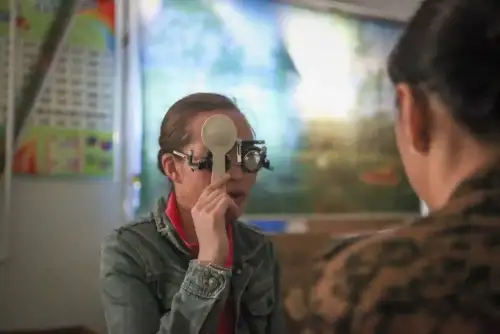
Celiac.com 08/04/2025 - Celiac disease is widely recognized as an autoimmune condition that primarily affects the small intestine and impairs nutrient absorption due to gluten exposure. Most people associate it with gastrointestinal symptoms like bloating, diarrhea, weight loss, and iron deficiency. However, celiac disease can impact other systems in the body as well, presenting a wide array of symptoms that may not seem related to digestion at all.
One such rare and lesser-known complication is uveitis, a form of eye inflammation that can lead to serious vision problems if left untreated. A recently documented case involving an 11-year-old girl from Pakistan sheds new light on this unusual connection between celiac disease and eye health, raising awareness about how gluten sensitivity can have unexpected and irreversible consequences.
A Case That Changed the Lens: Uveitis in a Child with No Gut Symptoms
Celiac.com Sponsor (A12):
In this unusual case, an 11-year-old girl experienced a gradual, painless loss of vision in both eyes over four months. Strikingly, she had no typical symptoms of celiac disease—no diarrhea, abdominal pain, or visible signs of malnutrition. Her initial eye examination revealed signs of inflammation, including anterior chamber cells and more severe problems like vitritis, vasculitis, choroiditis, and optic disc atrophy. Despite intensive treatment with corticosteroids—both oral and topical—the inflammation worsened.
Eventually, further testing and a comprehensive workup pointed to a surprising diagnosis: celiac disease. This rare association between celiac disease and bilateral posterior uveitis may not be intuitive, but it is a crucial finding that expands our understanding of how autoimmune diseases like celiac can impact more than just the gut.
Understanding the Link: How Celiac Disease May Cause Eye Inflammation
While the exact biological mechanism is still not fully understood, researchers suspect that in people with celiac disease, gluten exposure causes an overactive immune response. One theory is that gluten proteins increase gut permeability, allowing harmful substances to leak into the bloodstream. These substances may then trigger immune cells that mistakenly attack healthy tissues elsewhere in the body, including the eyes.
In celiac patients, the immune system often produces specific antibodies, such as anti-endomysial and anti-transglutaminase antibodies. These markers, which are used for diagnosis, may also play a role in broader autoimmune reactions affecting other organs. While rare, this pathway may explain how uveitis develops in people with untreated or undiagnosed celiac disease.
What the Evidence Shows: A Pattern Emerges
Though rare, the connection between celiac disease and uveitis is supported by several similar cases reported in medical literature. Most of these involve female children or young adults, which aligns with the general trend that autoimmune conditions tend to be more common in females. Interestingly, many of these patients had no classic gastrointestinal complaints at the time of their uveitis diagnosis. In several cases, uveitis was the first and only clue that led to the discovery of celiac disease.
A key takeaway from these cases is that corticosteroids—normally effective for managing uveitis—were not helpful on their own. The inflammation typically persisted or returned until a strict gluten-free diet was implemented. Once gluten was eliminated from the diet, uveitis symptoms improved dramatically or even disappeared completely. This pattern strongly suggests that gluten exposure was a driving factor in the immune response that caused the eye inflammation.
Hidden Danger: Why Celiac Disease Without GI Symptoms Can Be So Risky
Many people, including healthcare professionals, assume that celiac disease must involve noticeable digestive issues. However, research shows that up to half of all individuals with celiac disease present with non-gastrointestinal symptoms—or none at all. These extraintestinal manifestations can include neurological issues, skin rashes, reproductive problems, and in rare cases, eye inflammation like uveitis.
Because of this misconception, many people with celiac disease remain undiagnosed until serious complications arise. In the reported case, failure to recognize the root cause led to irreversible vision loss. This highlights the importance of considering celiac disease in patients with unexplained autoimmune symptoms, even if their gut appears to be functioning normally.
Diagnostic Clues and Red Flags
The key to identifying uveitis caused by celiac disease lies in looking beyond the obvious. If a patient presents with uveitis and does not respond to standard steroid treatment, it’s essential to explore less common causes. Blood tests for celiac disease—including anti-tissue transglutaminase and anti-endomysial antibodies—are relatively easy to perform and could reveal a hidden diagnosis. In children especially, growth delays, fatigue, anemia, and even subtle behavioral changes might point toward celiac disease, even without digestive issues.
A Gluten-Free Diet as a Lifesaving Treatment
In nearly all documented cases of uveitis linked to celiac disease, a strict gluten-free diet led to noticeable improvement. While corticosteroids helped manage symptoms temporarily, they failed to provide lasting relief until gluten was removed from the diet. This supports the idea that continued exposure to gluten may be the root cause of the immune response, and eliminating it is key to halting disease progression.
In some patients, adherence to a gluten-free diet not only resolved eye inflammation but also prevented future episodes. This underscores the importance of dietary compliance in managing celiac disease—not just for intestinal healing, but for preventing autoimmune damage in other organs.
Implications for the Celiac and Gluten-Sensitive Community
This case report and others like it emphasize a vital message for people living with celiac disease or gluten sensitivity: symptoms can go far beyond the digestive tract. It’s crucial for patients, parents, and clinicians to be aware of unusual presentations like eye inflammation, especially when the cause is unclear and symptoms do not improve with conventional treatments.
Early diagnosis and dietary management could make the difference between recovery and permanent damage. For families managing celiac disease in children, this means watching for subtle signs and advocating for comprehensive testing when autoimmune symptoms appear.
Conclusion: Seeing the Bigger Picture
The case of posterior uveitis as a manifestation of celiac disease in a child without gastrointestinal symptoms is a powerful reminder that celiac disease is a systemic autoimmune disorder—not just a digestive issue. While rare, the connection between eye inflammation and gluten sensitivity should not be overlooked, especially in patients who are unresponsive to typical treatments.
This insight can help prevent devastating complications like permanent vision loss and calls for greater awareness in both clinical practice and patient education. For anyone managing celiac disease or unexplained autoimmune symptoms, it reinforces a simple but vital truth: what you eat can affect every part of your body—including your eyes.
Read more at: cureus.com









Recommended Comments
Create an account or sign in to comment
You need to be a member in order to leave a comment
Create an account
Sign up for a new account in our community. It's easy!
Register a new accountSign in
Already have an account? Sign in here.
Sign In Now